|
Oracle® Application Server Adapter for PeopleSoft User's Guide
10g Release 2 (10.1.2) B14060-02 |
|
 Previous |
 Next |
|
Oracle® Application Server Adapter for PeopleSoft User's Guide
10g Release 2 (10.1.2) B14060-02 |
|
 Previous |
 Next |
OracleAS Adapter Application Explorer (Application Explorer) enables the processing of Component Interfaces and Messages.
External applications that access PeopleSoft through the adapter use either XML schemas or Web services to pass data between the external application and the adapter. You can use Application Explorer to create the required XML schemas and Web services.
This chapter discusses the following topics:
To start Application Explorer:
Ensure the server is started where Application Explorer is deployed.
On Windows, select Start >Programs > OracleAS_home Adapters > Application Explorer.
On Windows, iaexplorer.bat is found under OracleAS_home\adapters\application\tools, where OracleAS_home is the directory where Oracle Application Server is installed.
On UNIX, load the iwae script, iwae.sh, found under OracleAS_home/adapters/application/tools, where OracleAS_home is the directory where Oracle Application Server is installed.
Application Explorer starts. You are ready to define new targets to your PeopleSoft system.
Before a repository project can be created, you must configure BSE. You need not configure the OracleAS Adapter J2CA because the ra.xml file is configured automatically during installation.
After BSE is deployed to Oracle Application Server, you can configure it through the BSE configuration page. This configuration is required only when pointing to BSE using a database repository.
|
Note: Do not use a file repository for BSE in production environments. |
To configure BSE:
Display the following page in your browser:
http://hostname:port/ibse
Where hostname is the host name of Oracle Application Server and port is the HTTP port for Oracle Application Server.
For example,
http://localhost:7777/ibse
|
Note: If you are accessing this page for the first time, it may take longer to load. |
When prompted, log on.
When first installed, the user ID and password are:
User name: iway
Password: iway
The BSE configuration page is displayed.
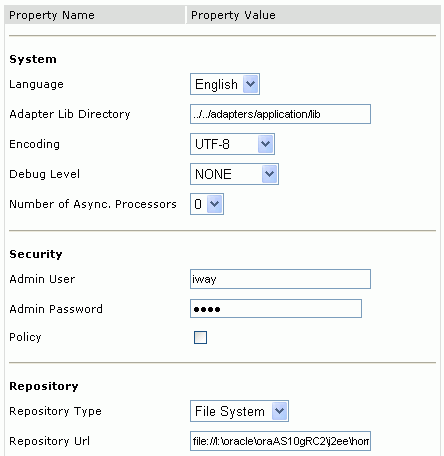
Ensure that the Adapter Lib Directory parameter specifies the path to the lib directory, for example:
OracleAS_home\adapters\application\lib
After you specify the path, adapters in the lib directory are available to BSE.
For security purposes, enter a new password in the Admin Password field.
|
Note: The Repository URL field specifies where the file system repository is located. To use a database repository, you must enter the repository connection information. For the initial verification, use a file system repository. See "Configuring an Oracle Repository" for information on switching to a database repository. |
Click Save.
To configure BSE system settings:
Display the BSE configuration page by entering the following URL in a browser:
http://hostname:port/ibse/IBSEConfig
Where hostname is the machine where BSE is installed and port is the port number on which BSE is listening.
|
Note: The server to which BSE is deployed must be running. |
The BSE settings pane is displayed, as shown in the following figure.
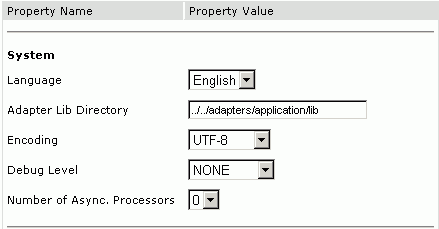
Configure the system settings.
The following table lists the parameters with descriptions of the information to provide.
Configure the security settings.

The following table lists the parameters with descriptions of the information to provide.
Configure the repository settings.
BSE requires a repository to store transactions and metadata required for the delivery of Web services.
See "Configuring a File System Repository" and "Configuring an Oracle Repository" for more information.
The following image shows all fields and check boxes for the Repository pane:

The following table lists the parameters with descriptions of the information to provide.
Configuring a File System Repository
If you do not have access to a database for the repository, you can store repository information in an XML file on your local machine. However, a file system repository is less secure and efficient than a database repository. When BSE is first installed, it is automatically configured to use a file system repository.
|
Note: Do not use a file repository for BSE in production environments. |
The default location for the repository on Windows is:
OracleAS_home\j2ee\OC4J_CONTAINER\applications\ws-app-adapter \ibse\ibserepo.xml
On other platforms, use the corresponding location.
If you are using a file system repository, you are not required to configure any additional BSE components.
Configuring an Oracle Repository
To configure an Oracle repository:
Contact your database administrator to obtain an Oracle user ID and password to create the BSE repository.
This user ID should have rights to create and modify tables as well as the ability to create and execute stored procedures.
Open a command prompt and navigate to the setup directory. Its default location on Windows is:
OracleAS_home\adapters\application\etc
For other platforms, see the corresponding location.
This directory contains SQL to create the repository tables in the following file:
iwse.ora
|
Note: If Oracle is not on the same machine as the Oracle Application Server, copy the iwse.ora file to the Oracle machine. Then, from a command prompt on the Oracle machine, navigate to the directory containing the iwse.ora file. |
sqlplus userid/password @database @ iwse.ora
During the J2CA deployment of OracleAS Adapter for PeopleSoft, OC4J generates a deployment descriptor called oc4j-ra.xml. This descriptor provides OC4J-specific deployment information for resource adapters. See Chapter 3, "OC4J Deployment and Integration" for more information on J2CA deployment and configuration.
No configuration changes are necessary if you are using the default file based repository with J2CA deployment.
Configuring a Database Repository for J2CA
To configure a database repository for J2CA:
Execute the iwse.ora SQL statement on the machine where the database is installed.
Copy the jcatransport.properties file to the following directory:
OracleAS_home\adapters\application\config\jca_sample
Uncomment the following fields and enter details for them in the jcatransport.properties file. For example:
iwafjca.repo.url=jdbc:oracle:thin:@90.0.0.51:1521:orcl iwafjca.repo.user=scott iwafjca.repo.password=scott1
Alter the JDBC driver path in Application Explorer's lcp. For example:
lcp=..\lib\orabpel-adapters.jar;C:\jdev\jdbc\lib\classes12.jar;C:\jdev\jdbc\lib\nls_charset12.jar;%lcp% to lcp=..\lib\orabpel-adapters.jar;..\..\..\jdbc\lib\classes12.jar;..\..\..\jdbc\lib\nls_charset12.jar;%lcp%
Before you use Application Explorer with OracleAS Adapter for PeopleSoft, you must create a repository configuration. You can create two kinds of repository configurations, Web services and J2CA, depending on the container to which the adapter is deployed. During design time, the repository is used to store metadata created when using Application Explorer to configure adapter connections, browse EIS objects, configure services, and configure listeners to listen for EIS events. The information in the repository is also referenced at runtime.
A default J2CA repository is created for the default ManagedConnectionFactory. The name of this configuration is jca_sample.
Web services and BSE refer to the same type of deployment. See "Adapter Features" for more information.
To create a configuration for BSE using Application Explorer, you must first define a new configuration.
Defining a New Configuration for BSE
To define a new configuration for BSE:
Right-click Configurations and select New.
Enter a name for the new configuration (for example, SampleConfig) and click OK.
The New Configuration dialog box is displayed.
In the BSE URL field, accept the default URL or replace it with a different URL with the following format:
http://hostname:port/ibse/IBSEServlet
Where hostname is the machine where your application server resides and port is the port number where the application server is listening.
Click OK.
A node representing the new configuration appears beneath the root Configurations node.

To create a configuration for OracleAS Adapter J2CA using Application Explorer, you must first define a new configuration.
Defining a New Configuration for J2CA
To define a new configuration for J2CA:
Right-click Configurations and select New.

The New Configuration dialog box is displayed.
Enter a name for the new configuration (for example, SampleConfig) and click OK.

In the Home field, enter a path to your J2CA configuration directory where the repository, schemas, and other information is stored, for example:
OracleAS_home\adapters\application
Click OK.
A node representing the new configuration appears beneath the root Configurations node.

The OracleAS Adapter J2CA configuration file is stored in OracleAS_home\adapters\application\config\configuration_name
Where configuration_name is the name of the configuration you created; for example, SampleConfig.
To connect to a new configuration:
Right-click the configuration to which you want to connect, for example, SampleConfig.
Select Connect.
Nodes appear for Adapters, Events, and Business Services (also known as Web services).

Use the Adapters folder to create inbound interaction with PeopleSoft. For example, you use the PeopleSoft node in the Adapters folder to configure a service that updates PeopleSoft.
Use the Events folder to configure listeners that listen for events in PeopleSoft.
Use the Business Services folder (available for BSE configurations only) to test Web services created in the Adapters folder. You can also control security settings for the Web services by using the security features of the Business Services folder.
You are now ready to define new targets to PeopleSoft.
Part of the application definition includes adding a target for OracleAS Adapter for PeopleSoft. Setting up the target in Application Explorer requires information that is specific to the target.
To browse PeopleSoft business objects, you must create a target for the system you intend to use. The target serves as your connection point and is automatically saved after you create it. You must establish a connection to this system every time you start Application Explorer or after you disconnect from the system.
When you launch Application Explorer, the left pane displays (as nodes) the application systems supported by Application Explorer, based on the adapters that are installed.
To connect to PeopleSoft for the first time, you must define a new target. OracleAS Adapter for PeopleSoft supports PeopleSoft standard security, in addition to component interface-level security. Once connected to the PeopleSoft application server, application security is managed by user ID, roles and privileges. For more information on PeopleSoft application security, see the appropriate PeopleSoft documentation.
Defining a Target for PeopleSoft
To define a target:
In the left pane, expand the Adapters node.
The applications systems supported by Application Explorer appear as nodes based on the adapters that are installed.

Right-click the PeopleSoft node and select Add Target.
The Add Target dialog box is displayed. Provide the following information:
In the Name field, enter a descriptive name for the target, for example, PSoftTarget.
In the Description field, enter a description for the target (optional).
From the Target Type list, select Application Server.
This is the only possible value for target type.
Click OK.
The Application Server dialog box is displayed. You must specify connection information for PeopleSoft and the application server that is hosting PeopleSoft.

Provide the following information:
In the Application Server field, enter the host name or IP address for the computer that is hosting the PeopleSoft application.
In the Port field, enter the port number where the PeopleSoft application is listening.
In the User field, enter a valid user ID for the PeopleSoft application.
In the Password field, enter a valid password for the PeopleSoft application.
Click OK.
In the left pane, the new target (PSoftTarget) appears the PeopleSoft node.

To connect to a target:
In the left pane, expand the Adapters node.
Expand the PeopleSoft node.
Click the target name (for example, PSoftTarget) under the PeopleSoft node.
The Connection dialog box displays the values you entered for connection parameters.
Provide the correct password.
Right-click the target name and select Connect.
The x icon disappears, indicating that the node is connected. A list of PeopleSoft business objects is displayed.

Description of the illustration wlw_newtarget7.gif
Although you can maintain multiple open connections to different transaction processing systems, it is recommended that you disconnect from connections not in use. After you disconnect, you can modify an existing target.
You can modify the connection parameters when your system properties change. You also can delete a target. The following procedures describe how to disconnect from a target, edit a target, and delete a target.
Disconnecting from a Connection to PeopleSoft
To disconnect from a connection to PeopleSoft:
Expand the Adapters node.
Expand the PeopleSoft node.

Right-click the target to which you are connected (for example, PSoftTarget), and select Disconnect.
Disconnecting from PeopleSoft drops the connection with PeopleSoft, but the node remains. The x icon appears, indicating that the node is disconnected.
Deleting a Connection to PeopleSoft
To delete a connection to PeopleSoft:
Expand the Adapters node.
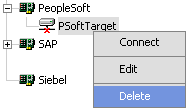
Right-click the target to which you are connected (for example, PsoftTarget), and select Delete.
The node disappears from the list of available connections.
Modifying a Target
After you create a target for PeopleSoft using Application Explorer, you can edit any of the information that you provided previously.
Ensure that the target you want to edit is disconnected.

In the left pane, right-click the target and select Edit.
The Application Server dialog box is displayed.

Change the properties in the dialog box as required and click OK.
After you are connected to PeopleSoft, Application Explorer enables you to explore and browse business object metadata. For example, Application Explorer enables you to view PeopleSoft Component Interface and Message metadata stored in the PeopleSoft business object repository.
For Component Interfaces(RPC), the adapter enables Delete, Insert, Query, Update, and Find.
To view application system objects:
Click the icon to the left of the target name, for example, PSoftTarget.
The target expands and the available system objects are displayed.

To expand the desired PeopleSoft repository node, click the icon to the left of the repository name, for example, Component Interfaces.
A list of PeopleSoft Component Interfaces appears. You can now generate schemas.
After you browse the PeopleSoft business object repository, you can generate XML request and response schemas for the object you wish to use with your adapter.
Creating XML Request and Response Schemas Against BSE
To create XML request and response schemas for a PeopleSoft Component Interface against a BSE implementation:
Expand the PeopleSoft node and then, expand the Component Interfaces node.
From the list of Component Interfaces, select LOCATION.
Click the Request Schema or Response Schema tab to view the request schema information.
The schema you selected appears.
After you browse the Component Interfaces and make a selection, the request and response XML schemas are automatically created for that Component Interface and stored in the repository you created.
Creating XML Request and Response Schemas Against the OraclesAS Adapter J2CA
To create XML request and response schemas for a PeopleSoft Component Interface against an OraclesAS Adapter J2CA implementation:
Expand the PeopleSoft node and then, expand the Component Interfaces node.
From the list of Component Interfaces, select LOCATION.
Click the Request Schema or Response Schema tab to view the request schema information.
The schema you selected appears.
After you browse the Component Interfaces and make a selection, the request and response XML schemas are automatically created for that Component Interface and stored in the repository you created.
The Web Service Definition Language (WSDL) description of a service enables you to make the service available to other services within a host server. You use Application Explorer to create both request-response (outbound) and event notification (inbound) JCA services of the adapter.
|
Note: The Create Inbound JCA Service (Event) option is only available when the selected node supports events. |
To generate a WSDL file for request-response service:
After you create a schema, right-click the respective object.
The following menu is displayed.

Select Create Outbound JCA Service (Request/Response).
The Export WSDL dialog box is displayed.

Accept the default name and location for the file.
The .wsdl file extension is added automatically. By default, the names of WSDL files generated for request-response services end with _invoke, while those generated for event notification end with _receive.
|
Note: You can organize your WSDL files in subfolders, creating your own WSDL hierarchy structure. Create the folders underOracleAS_home\adapters\application\wsdls\. The WSIL browser in JDeveloper will display the full tree structure of your WSDL hierarchy.
|
Click OK.
You can create Web services (also known as a business service) using Application Explorer. The PeopleSoft Component Interface called LOCATION is used as an example in the following procedure.
|
Note: In a J2EE Connector Architecture (J2CA) implementation of adapters, Web services are not available. When the adapters are deployed to use OracleAS Adapter for J2CA, the Common Client Interface provides integration services using the adapters. |
Creating a Web Service
To create a Web service, perform the following steps:
Expand the PeopleSoft node and then, expand the Component Interfaces node.
From the list of Component Interfaces, select LOCATION.
Right-click the node from which you want to create a business service and select Create Business Service.
The Create Web Service dialog box is displayed.
You can add the business function as a method for a new Web service or as a method for an existing one. Perform the following steps:
From the Existing Service Names list, select either <new service> or an existing service.
Specify a service name if you are creating a new service. This name identifies the Web service in the list of services under the Business Services node.
Enter a description for the service (optional).
Select one of the available licenses.
Click Next.
The License and Method dialog box is displayed. Perform the following steps:
In the License field, select one or more license codes to assign to the Web service. To select more than one, hold down the Ctrl key and click the licenses.
In the Method Name field, enter a descriptive name for the method.
In the Description field, enter a brief description of the method.
Click OK.
Application Explorer switches the view to the Business Services node, and the new Web service appears in the left pane.
Testing a Web Service
After a Web service is created, you can test it to ensure that it functions properly. A test tool is provided for testing the Web service.
To test a business service:
If you are not on the Business Services node of Application Explorer, click the node to access Web services.
If it is not expanded, expand the list of Web services under Business Services.
Expand the Services node.
Select the name of the business service you want to test.
The business service name appears as a link in the right pane.
In the right pane, click the named business services link.
The test option appears in the right pane.If you are testing a Web service that requires XML input, an input field appears.
Enter the appropriate input.
Click Invoke.
Application Explorer displays the results.
Identity Propagation
If you test or execute a Web service using a third party XML editor, for example XMLSPY, the Username and Password values that you specify in the SOAP header must be valid and are used to connect to PeopleSoft. The user name and password values that you provided for PeopleSoft during target creation using Application Explorer are overwritten for this Web service request. The following is a sample SOAP header that is included in the WSDL file for a Web service:
<SOAP-ENV:Header>
<m:ibsinfo xmlns:m="urn:schemas-iwaysoftware-com:iwse">
<m:service>String</m:service>
<m:method>String</m:method>
<m:license>String</m:license>
<m:disposition>String</m:disposition>
<m:Username>String</m:Username>
<m:Password>String</m:Password>
<m:language>String</m:language>
</m:ibsinfo>
</SOAP-ENV:Header>
You can remove the <m:disposition> and <m:language> tags from the SOAP header, since they are not required.
Events are generated as a result of activity in an application system. You can use events to trigger an action in your application. For example, PeopleSoft may generate an event when customer information is updated. If your application performs an action when this happens, your application is a consumer of this event.
After you create a connection to your application system, you can add events using Application Explorer. To create an event, you must create a port and a channel.
|
Note: If using a J2CA configuration, you must create a new channel for every event and select this channel when creating an inbound service. Additionally, you do not create or configure ports for use with BPEL Process Manager. |
A port associates a particular business object exposed by the adapter with a particular disposition. A disposition is a URL that defines the protocol and location of the event data. The port defines the end point of the event consumption. See "Creating an Event Port" for more information.
A channel represents configured connections to particular instances of back-end systems. A channel binds one or more event ports to a particular listener managed by the adapter. See "Creating a Channel" for more information.
|
Note: Oracle Containers for J2EE (OC4J) currently conforms to J2CA 1.0, which does not call for event capabilities. When conforming to J2CA 1.0, only service interactions are supported. |
Application Explorer enables you to create event ports from the Adapters node or from the Events node.
|
Note: Do not create event ports for J2CA configurations. You must create event ports for BSE configurations only. |
Creating an Event Port from the Adapters Node
You can bypass the Events node and create an event port directly from the Adapters node. Perform the following steps:
Right-click any node under Messages.
Select Create Event Port. You should not select Add Port.
The Create Event Port dialog is displayed. Perform the following steps:
Enter a name for the event port and provide a brief description.
From the list, select the required disposition, for example, File.
Enter the disposition URL.
Click OK.
See "Creating an Event Port from the Events Node" for information on configuring port dispositions.
Creating an Event Port from the Events Node
The following procedures describe how to create an event port from the Events node for various dispositions using Application Explorer. You can switch between a BSE and a J2CA deployment by choosing one or the other from the menu in the upper right of Application Explorer.
Creating an Event Port for RMI
To create a specific event port for RMI:
Click the Events node.
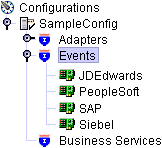
Expand the PeopleSoft node.
Right-click the Ports node and select Add Port.
The Add Port dialog box is displayed. Perform the following steps:
Enter a name for the event port and provide a brief description.
From the Protocol list, select RMI.
In the URL field, specify a destination file to which the event data is written using the following format:
rmi://host:port;RemoteObject=[APPNAME];errorTo=[pre-defined port name or another disposition url]
From the Disposition protocol list, select RMI.
The following table defines the parameters for the disposition.
| Parameter | Description |
|---|---|
| host | The host name or IP address from which the RMI server accepts RMI requests. If you omit this attribute, the RMI server will accept RMI requests from any host. |
| port | The port number on which the RMI server listens for RMI requests. |
| RemoteObject | A home or Enterprise JavaBeans (EJB) object. |
| errorTo | Predefined port name or another disposition URL to which error logs are sent. |
Click OK.
The port appears under the ports node in the left pane. In the right pane, a table appears that summarizes the information associated with the event port you created.
You are ready to associate the event port with a channel. See "Creating a Channel" for more information.
The port appears under the ports node in the left pane. In the right pane, a table appears that summarizes the information associated with the event port you created.
In the left pane, select the event port you want to edit.
Right-click the port and select Edit.
The Edit Port pane is displayed.
Make the required changes and click OK.
The following procedures describe how to create a channel for your event. All defined event ports must be associated with a channel.
|
Note: If using a J2CA configuration, you must create a new channel for every event and select this channel when creating an inbound service. Creating a channel is required for both BSE and J2CA configurations. |
Creating a Channel Using Specific Protocols
You can create the following types of channels using Application Explorer:
TCP
HTTP
File
The following procedures explain how to create these channels.
|
Note: OC4J currently conforms to J2CA 1.0, which does not call for event capabilities. When conforming to J2CA 1.0, only service interactions are supported. |
Click the Events node.
Expand the PeopleSoft node.
The ports and channels nodes appear in the left pane.
Right-click Channels and select Add Channel.
The Add Channel dialog box is displayed.
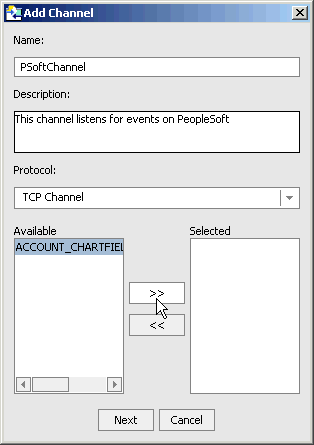
Perform the following steps:
Enter a name for the channel, for example, NewChannel.
Enter a brief description.
From the Protocol list, select TCP Channel.
Click the double right (>>) arrow to transfer the ports to the list of selected ports.
Click Next.
Enter the information that is specific to your PeopleSoft system and the channel you are creating.
The TCP Listener dialog box is displayed.
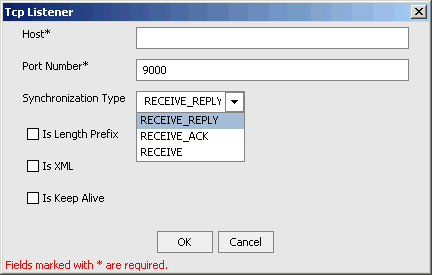
Provide the following information:
The channel appears the Channels node in the left pane.

When you select the event port, the channel information appears in the right pane.
Click OK.
The channel appears under the channels node in the left pane.
An X over the icon indicates that the channel is currently disconnected. You must start the channel to activate your event configuration.
Right-click the channel node and select Start.
The channel becomes active.

The X that was over the icon in the left pane disappears.
|
Note: If you are planning to integrate OracleAS Adapter for PeopleSoft with BPEL Process Manager, do not start the channel, as it is managed by the BPEL PM Server. If you start the channel for testing and debugging purposes, stop it before runtime. |
To stop the channel, right-click the connected channel node and select Stop.
The channel becomes inactive and an X appears over the icon.
To create an HTTP Channel:
Click the Events node.
Expand the PeopleSoft node.
The ports and channels nodes appear in the left pane.
Right-click Channels and select Add Channel.
The Add Channel dialog box is displayed. Provide the following information:
Enter a name for the channel, for example, NewChannel.
Enter a brief description.
From the list, select HTTP Listener.
Select an event port from the list of available ports.
To transfer the port to the list of available ports, click the double right (>>) arrow. To associate all the event ports, control-click to select each port or click one port and press Control+A. Then, click the double right (>>) arrow.
Click Next.
When the dialog box is displayed, enter the system information as specified in the following table:
| Parameter | Description |
|---|---|
| Port | Port on which to listen for PeopleSoft event data. |
| Server port | Port on which the host database is listening. |
| Synchronization Type | Choose from three synchronization options:REQUESTREQUEST_RESPONSEREQUEST_ACK |
Click OK.
A summary pane is displayed, providing the channel description, channel status, and available ports. All the information is associated with the channel you created.The channel also appears under the channels node in the left pane
An X over the icon indicates that the channel is currently disconnected. You must start the channel to activate your event configuration.
Right-click the channel and select Start the channel.
The channel you created becomes active.
The X that was over the icon in the left pane disappears.
To stop the channel, right-click the channel and select Stop the channel.
To create a channel for the File listener:
Click the Events node.
In the left pane, expand the PeopleSoft node.
The ports and channels nodes appear.
Right-click Channels and select Add Channel.
The Add Channel dialog box is displayed. Perform the following steps:
Enter a name for the channel, for example, NewChannel.
Enter a brief description.
From the list, select File Listener.
Select an event port from the list of available ports.
To transfer the port to the list of available ports, click the double right (>>) arrow. To associate all the event ports, control-click to select each port or click one port and press Control+A. Then, click the double right (>>) arrow.
Click Next.
When the dialog box is displayed, enter the system information as follows:
In the Request tab, enter values for the following parameters:
| Parameter | Description |
|---|---|
| Polling Location | Target file system location for the PeopleSoft XML file. |
| File Mask | File name to be used for the output file generated as a result of the operation. |
In the Response tab, enter values for the following parameters:
| Parameter | Description |
|---|---|
| Synchronization Type | Target file system location for the PeopleSoft XML file. |
| Response/Ack Directory | Choose from three options:
REQUEST REQUEST_RESPONSE REQUEST_ACK |
In the Advanced tab, enter values for the following parameters:
| Parameter | Description |
|---|---|
| Error directory | Directory to which documents with errors are written. |
| Poll interval (msec) | Interval (in milliseconds) when to check for new input. The default is three seconds. Optional. |
| Processing Mode | Sequential indicates single processing of requests.
Threaded indicates processing of multiple requests simultaneously. |
| Thread limit | If you selected threaded processing, indicate the maximum number of requests that can be processed simultaneously. |
Click OK.
A summary pane is displayed, providing the channel description, channel status, and available ports. All the information is associated with the channel you created.The channel also appears under the channels node in the left pane
An X over the icon indicates that the channel is currently disconnected. You must start the channel to activate your event configuration.
Right-click the channel and select Start the channel.
The channel you created becomes active.
The X that was over the icon in the left pane disappears.
To stop the channel, right-click the channel and select Stop the channel.
Editing a Channel
In the left pane, locate the channel you want to edit.
Right-click the channel and select Edit.
The Edit channels pane is displayed.
Make the required changes to the channel configuration and click Finish.
Deleting a Channel
To delete a channel: